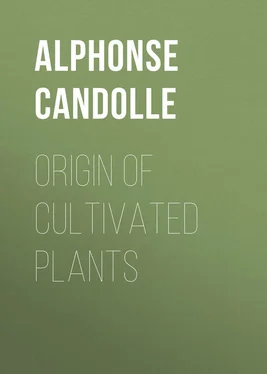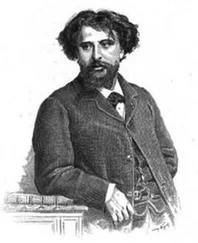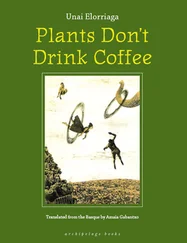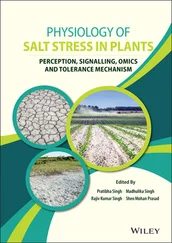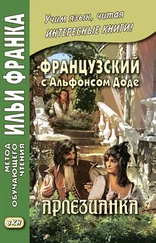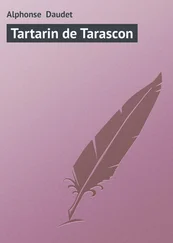Alphonse Candolle - Origin of Cultivated Plants
Здесь есть возможность читать онлайн «Alphonse Candolle - Origin of Cultivated Plants» — ознакомительный отрывок электронной книги совершенно бесплатно, а после прочтения отрывка купить полную версию. В некоторых случаях можно слушать аудио, скачать через торрент в формате fb2 и присутствует краткое содержание. Жанр: foreign_antique, foreign_prose, на английском языке. Описание произведения, (предисловие) а так же отзывы посетителей доступны на портале библиотеки ЛибКат.
- Название:Origin of Cultivated Plants
- Автор:
- Жанр:
- Год:неизвестен
- ISBN:нет данных
- Рейтинг книги:4 / 5. Голосов: 1
-
Избранное:Добавить в избранное
- Отзывы:
-
Ваша оценка:
- 80
- 1
- 2
- 3
- 4
- 5
Origin of Cultivated Plants: краткое содержание, описание и аннотация
Предлагаем к чтению аннотацию, описание, краткое содержание или предисловие (зависит от того, что написал сам автор книги «Origin of Cultivated Plants»). Если вы не нашли необходимую информацию о книге — напишите в комментариях, мы постараемся отыскать её.
Origin of Cultivated Plants — читать онлайн ознакомительный отрывок
Ниже представлен текст книги, разбитый по страницам. Система сохранения места последней прочитанной страницы, позволяет с удобством читать онлайн бесплатно книгу «Origin of Cultivated Plants», без необходимости каждый раз заново искать на чём Вы остановились. Поставьте закладку, и сможете в любой момент перейти на страницу, на которой закончили чтение.
Интервал:
Закладка:
Botanists are in many cases forced to doubt the common names attributed to plants by travellers, historians, and philologists. This is a consequence of their own doubts respecting the distinction of species and of the well-known difficulty of ascertaining the common name of a plant. The uncertainty becomes yet greater in the case of species which are more easily confounded or less generally known, or in the case of the languages of little-civilized nations. There are, so to speak, degrees of languages in this respect, and the names should be accepted more or less readily according to these degrees.
In the first rank, for certainty, are placed those languages which possess botanical works. For instance, it is possible to recognize a species by means of a Greek description by Dioscorides or Theophrastus, and by the less complete Latin texts of Cato, Columella, or Pliny. Chinese books also give descriptions. Dr. Bretschneider, of the Russian legation at Pekin, has written some excellent papers upon these books, from which I shall often quote. 20 20 Bretschneider, On the Study and Value of Chinese Botanical Works, with Notes on the History of Plants and Geographical Botany from Chinese Sources , in 8vo, 51 pp., with illustrations, Foochoo, without date, but the preface bears the date Dec. 1870. Notes on Some Botanical Questions , in 8vo, 14 pp., 1880.
The second degree is that of languages possessing a literature composed only of theological and poetical works, or of chronicles of kings and battles. Such works make mention here and there of plants, with epithets or reflections on their mode of flowering, their ripening, their use, etc., which allow their names to be divined, and to be referred to modern botanical nomenclature. With the added help of a knowledge of the flora of the country, and of the common names in the languages derived from the dead language, it is possible to discover approximately the sense of some words. This is the case with Sanskrit, 21 21 Wilson’s dictionary contains names of plants, but botanists have more confidence in the names indicated by Roxburgh in his Flora Indica (edit. of 1832, 3 vols. in 8vo), and in Piddington’s English Index to the Plants of India , Calcutta, 1832. Scholars find a greater number of words in the texts, but they do not give sufficient proof of the sense of these words. As a rule, we have not in Sanskrit what we have in Hebrew, Greek, and Chinese – a quotation of phrases concerning each word translated into a modern language.
Hebrew, 22 22 The best work on the plant-names in the Old Testament is that of Rosenmüller, Handbuch der biblischen Alterkunde , in 8vo, vol. iv., Leipzig, 1830. A good short work, in French, is La Botanique de la Bible , by Fred. Hamilton, in 8vo, Nice, 1871.
and Armenian. 23 23 Reynier, a Swiss botanist, who had been in Egypt, has given the sense of many plant-names in the Talmud. See his volumes entitled Economie Publique et Rurale des Arabes et des Juifs , in 8vo, 1820; and Economie Publique et Rurale des Egyptiens et des Carthaginois , in 8vo, Lausanne, 1823. The more recent works of Duschak and Löw are not based upon a knowledge of Eastern plants, and are unintelligible to botanists because of names in Syriac and Hebrew characters.
Lastly, a third category of dead languages offers no certainty, but merely presumptions or hypothetical and rare indications. It comprehends those tongues in which there is no written work, such as Keltic, with its dialects, the ancient Sclavonic, Pelasgic, Iberian, the speech of the primitive Aryans, Turanians, etc. It is possible to guess certain names or their approximate form in these dead languages by two methods, both of which should be employed with caution.
The first and best is to consult the languages derived, or which we believe to be derived, directly from the ancient tongues, as Basque for the Iberian language, Albanian for the Pelasgic, Breton, Erse, and Gaelic for Keltic. The danger lies in the possibility of mistake in the filiation of the languages, and especially in a mistaken belief in the antiquity of a plant-name which may have been introduced by another people. Thus the Basque language contains many words which seem to have been taken from the Latin at the time of the Roman rule. Berber is full of Arab words, and Persian of words of every origin, which probably did not exist in Zend.
The other method consists in reconstructing a dead language which had no literature, by means of those which are derived from it; for instance, the speech of the Western Aryans, by means of the words common to several European languages which have sprung from it. Fick’s dictionary will hardly serve for the words of ancient Aryan languages, for he gives but few plant-names, and his arrangement renders it unintelligible to those who have no knowledge of Sanskrit. Adolphe Pictet’s work 24 24 Adolphe Pictet, Les Origines des Peuples Indo-Européens , 3 vols, in 8vo, Paris, 1878.
is far more important to naturalists, and a second edition, augmented and improved, has been published since the author’s death. Plant-names and agricultural terms are explained and discussed in this work, in a manner all the more satisfactory that an accurate knowledge of botany is combined with philology. If the author attributes perhaps too much importance to doubtful etymologies, he makes up for it by other knowledge, and by his excellent method and lucidity.
The plant-names of the Euskarian or Basque language have been considered from the point of view of their probable etymology by the Comte de Charencey, in Les Actes de la Société Philologique (vol. i. No. 1, 1869). I shall have occasion to quote this work, of which the difficulties were great, in the absence of all literature and of all derived languages.
6. The necessity for combining the different methods. The various methods of which I have spoken are of unequal value. It is clear that when we have archæological records about a given species, like those of the Egyptian monuments, or of the Swiss lake-dwellings, these are facts of remarkable accuracy. Then come the data furnished by botany, especially those on the spontaneous existence of a species in a given country. These, if examined with care, may be very important. The assertions contained in the works of historians or even of naturalists respecting an epoch at which science was only beginning, have not the same value. Lastly, the common names are only an accessory means, especially in modern languages, and a means which, as we have seen, is not entirely trustworthy. So much may be said in a general way, but in each particular case one method or the other may be more or less important.
Each can only lead to probabilities, since we are dealing with facts of ancient date which are beyond the reach of direct and actual observation. Fortunately, if the same probability is attained in three or four different ways, we approach very near to certainty. The same rule holds good for researches into the history of plants as for researches into the history of nations. A good author consults historians who have spoken of events, the archives in which unpublished documents are found, the inscriptions on ancient monuments, the newspapers, private letters, finally memoirs and even tradition. He gathers probabilities from every source, and then compares these probabilities, weighs and discusses them before deciding. It is a labour of the mind which requires intelligence and judgment. This labour differs widely from observation employed in natural history, and from pure reason which is proper to the exact sciences. Nevertheless, when, by several methods, we reach the same probability, I repeat that the latter is very nearly a certainty. We may even say that it is as much a certainty as historical science can pretend to attain.
Читать дальшеИнтервал:
Закладка:
Похожие книги на «Origin of Cultivated Plants»
Представляем Вашему вниманию похожие книги на «Origin of Cultivated Plants» списком для выбора. Мы отобрали схожую по названию и смыслу литературу в надежде предоставить читателям больше вариантов отыскать новые, интересные, ещё непрочитанные произведения.
Обсуждение, отзывы о книге «Origin of Cultivated Plants» и просто собственные мнения читателей. Оставьте ваши комментарии, напишите, что Вы думаете о произведении, его смысле или главных героях. Укажите что конкретно понравилось, а что нет, и почему Вы так считаете.
